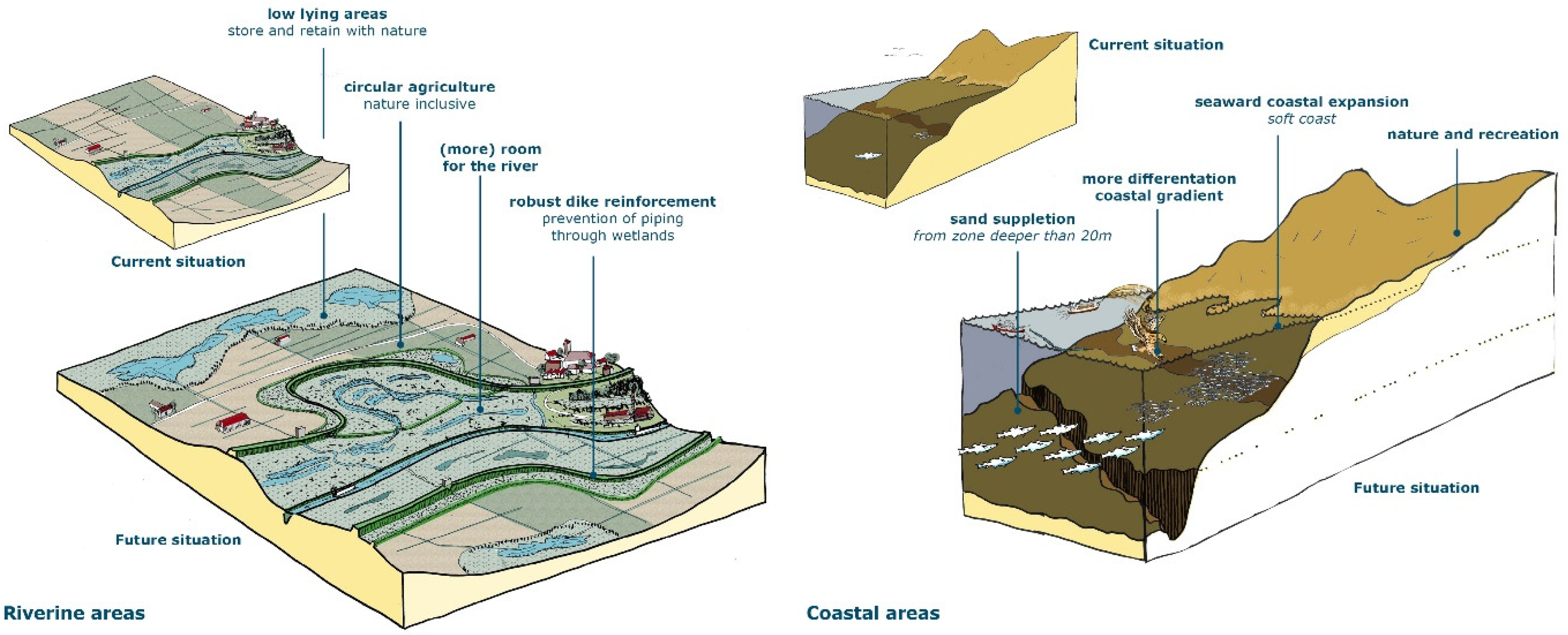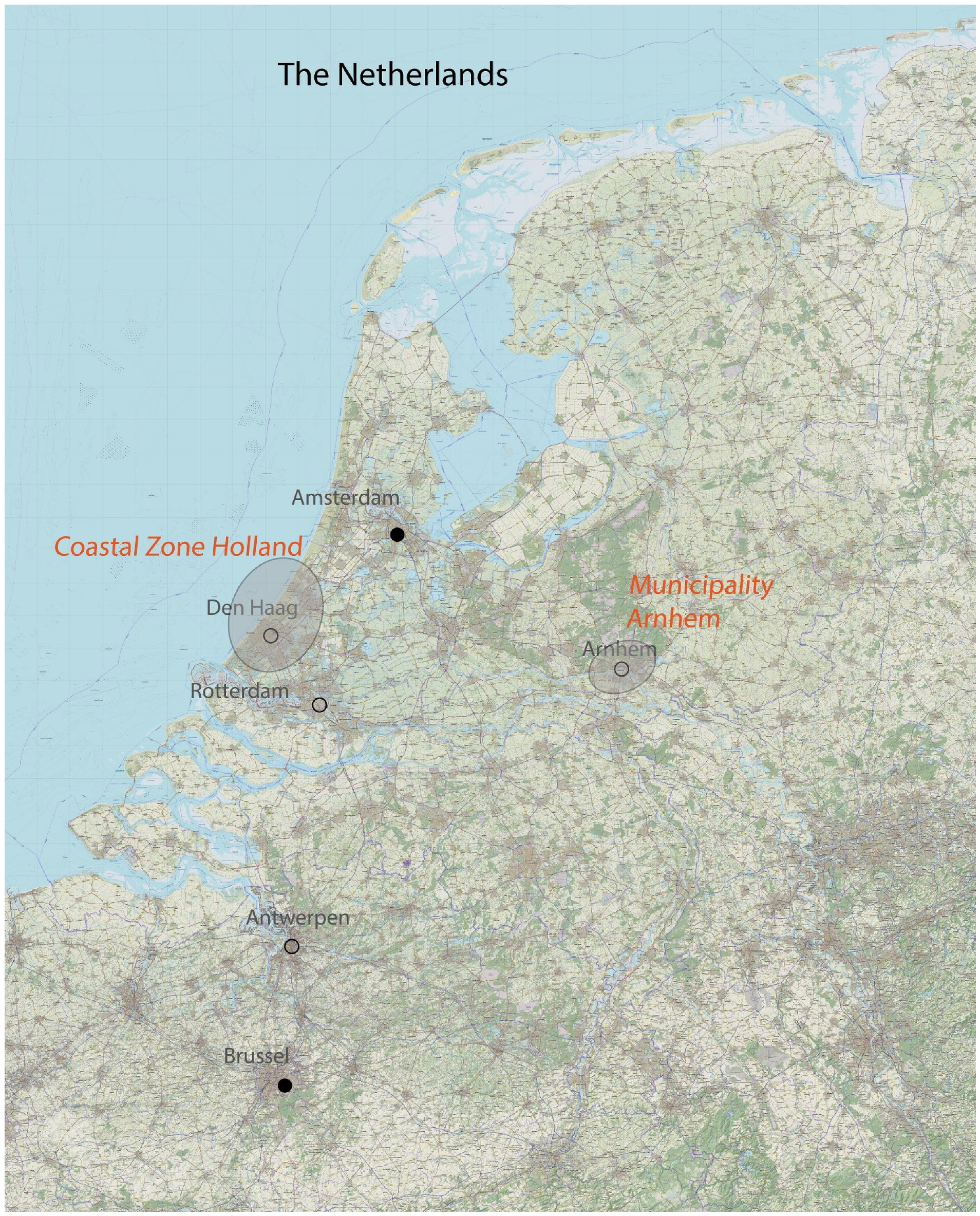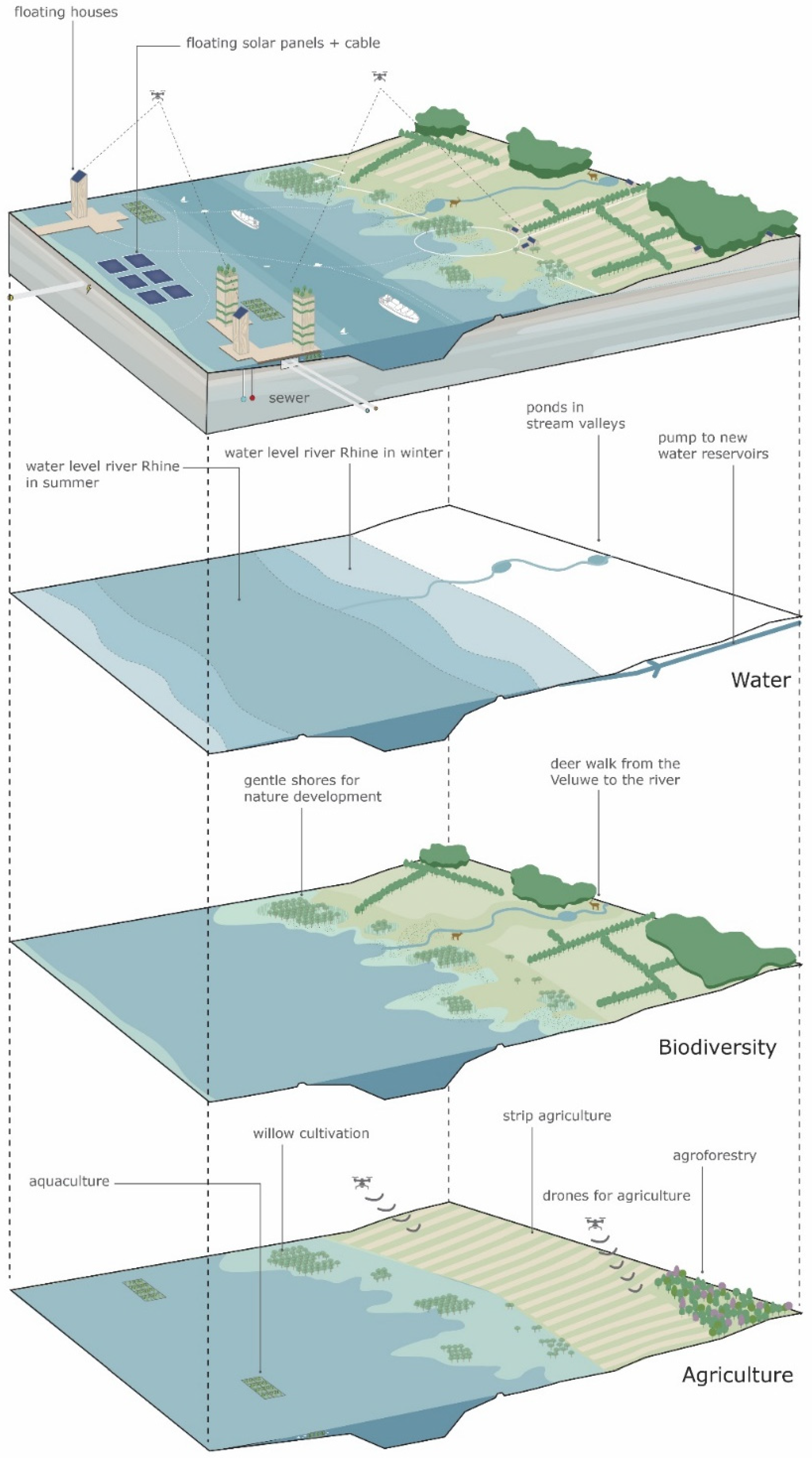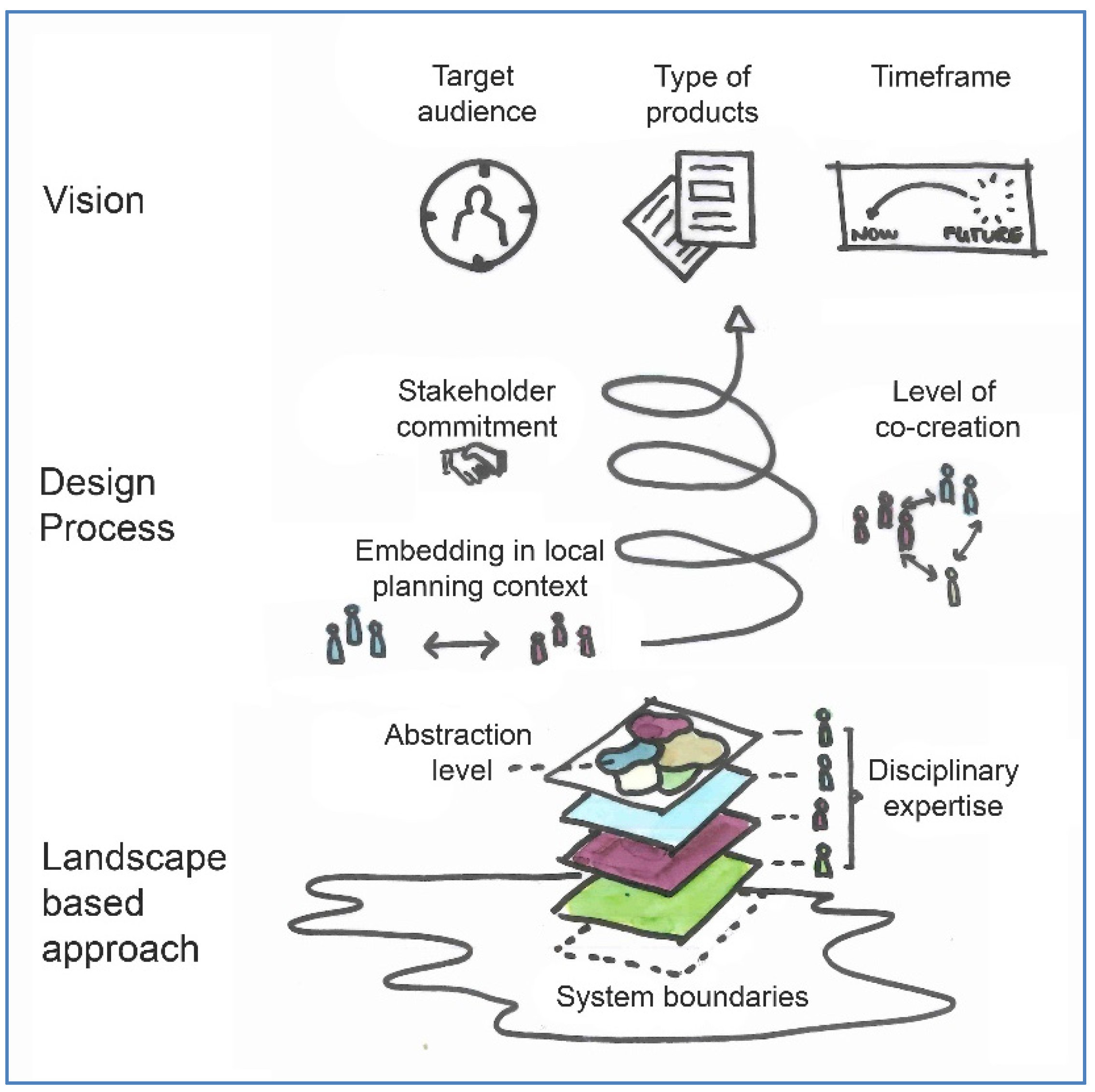Long-Term Visioning for Landscape-Based Spatial Planning—Experiences from Two Regional Cases in The Netherlands
Abstract
1. Introduction
- The natural system as the starting point;
- Optimal use of water;
- Nature-inclusive society;
- Circular economy;
- Adaptive spatial planning.
2. Theory and Reference to Recent Insights
2.1. The Design Process of Visioning to Support Sound Spatial Transitions
2.2. Landscape-Based Approach
3. Methods
3.1. Case Comparison
3.2. Introduction to the Cases
3.2.1. Municipality of Arnhem
3.2.2. Coastal Zone Holland
- The connection of the region with the North Sea will be strengthened. The North Sea will become an important production area for energies, protein rich food, and for growing biobased resources, next to sustainable transport, recreation, and biodiversity.
- The Coast and Dunes need to be strengthened by nature-based solutions, in order to protect the region from sea level rise. This will be realised in combination with recreation and nature management. The dune landscape will be connected with green city infrastructures and the polders.
- The Green City area innovations will green the city in order to decrease the heat island effect and to absorb heavy rainfall. Greening the cities will also have positive effects on biodiversity, health, and society.
- The Smart City area includes the basic concerns that, from the perspective of climate change, urban functions cannot extend towards the low-lying parts of the region. Therefore housing, business, and mobility should be smartly combined and reconfigured within the current urban areas, searching for new multifunctional combinations, for example, at public transport hubs or at campus environments. Furthermore, walking and cycling will become more important, and a ban on car dependency is foreseen.
- The Polder will have an important function in climate adaptation, as the landowners (often farmers) will contribute to storing the water, due to the flooding and heavy rainfall. This means that the area will become wetter and will be suitable for new crops. Agriculture will also have an important function in the mitigation of carbon emissions and in nature management and recreational services. Housing is only possible floating on the water.
4. Results
4.1. The Landscape-Based Approach
4.2. The Design Process
4.3. The Future Visions
5. Discussion
6. Conclusions and Recommendations
- Make optimal use of the free, daring, and, above all, inspiring character of long-term visioning in a broad spatial context beyond local concerns.
- Take the qualities and carrying capacity of the natural system as the starting point: adopt a landscape-based approach.
- Foster the integrative and creative nature of the design process to develop an innovative, motivational, and systemic vision.
- Design a possible positive future in the first place rather than a mitigated or adapted world.
- Envision fundamental transition pathways using societal trends and economic reasoning to strengthen the sustainable functioning of the landscape.
Author Contributions
Funding
Acknowledgments
Conflicts of Interest
References
- Fleming, R.; Mauger, R. Green and just? An update on the ‘European Green Deal’. J. Eur. Environ. Plan. Law 2021, 18, 164–180. [Google Scholar]
- Senge, P.M.; Scharmer, C.O.; Jaworski, J.; Flowers, B.S. Presence: Human Purpose, and the Field of the Future; Society for Organizational Learning: Cambridge, MA, USA, 2004. [Google Scholar]
- EC. European Territorial Agenda 2030: A Future for all Places. In Proceedings of the Informal Meeting of Ministers Responsible for Spatial Planning and Territorial Development and/or Territorial Cohesion, Berlin, Germany, 1 December 2020. [Google Scholar]
- EC/UN-HABITAT. The State of European Cities 2016: Cities leading the Way to a Better Future; E.C.U. Habitat, Ed.; Publications Office of the European Union: Luxembourg, 2016; p. 216. [Google Scholar]
- Mens, M.; Minnema, B.; Overmars, K.; van der Hurk, B. Dilemmas in developing models for long-term drought risk management: The case of the National Water Model of the Netherlands. Environ. Model. Softw. 2021, 143, 105100. [Google Scholar] [CrossRef]
- Hegger, D.; Alexander, M.; Raadgever, T.; Priest, S.; Bruzzone, S. Shaping flood risk governance through science-policy interfaces: Insights from England, France and the Netherlands. Environ. Sci. Policy 2020, 106, 157–165. [Google Scholar] [CrossRef]
- Glas, P. ‘Spoor 2’ Briefadvies Woningbouw en Klimaatadaptatie; Deltacommissaris: The Hague, The Netherlands, 2021; p. 10. [Google Scholar]
- De Jonge, H. General Policy Letter of the Minister of Housing and Spatial Planning 2022; Ministry of the Interior and Kingdom Relations: The Hague, The Netherlands, 2022; p. 15. [Google Scholar]
- Korthals Altes, W.K. Planning reform beyond planning: The debate on an integrated Environment and Planning Act in the Netherlands. Plan. Pract. Res. 2016, 31, 420–434. [Google Scholar] [CrossRef]
- Montanarella, L.; Panagos, P. The relevance of sustainable soil management within the European Green Deal. Land Use Policy 2021, 100, 104950. [Google Scholar] [CrossRef]
- Raaphorst, K.; van der Knaap, W.; van der Brink, A.; Roeleveld, G. Visualization, participation and rhetoric: The discursive power of landscape design representations in participatory processes. J. Landsc. Archit. 2019, 14, 42–53. [Google Scholar] [CrossRef]
- Baptist, M.; van Hattum, T.; Reinhard, S.; van Buuren, M.; de Rooji, B.; Hu, X.; van Rooij, S.; Polman, N.; van der Burg, S.; Piet, G. A Nature-Based Future for the Netherlands in 2120; Wageningen University & Research: Wageningen, The Netherlands, 2019. [Google Scholar]
- Wiek, A.; Iwaniec, D. Quality criteria for visions and visioning in sustainability science. Sustain. Sci. 2014, 9, 497–512. [Google Scholar] [CrossRef]
- McPhearson, T.; Iwaniec, D.M.; Bai, X. Positive visions for guiding urban transformations toward sustainable futures. Curr. Opin. Environ. Sustain. 2016, 22, 33–40. [Google Scholar] [CrossRef]
- Van Rooij, S.; Timmermans, W.; Roosenschoon, O.; Keesstra, S.; Sterk, M.; Pedroli, B. Landscape-Based Visions as Powerful Boundary Objects in Spatial Planning: Lessons from Three Dutch Projects. Land 2021, 10, 16. [Google Scholar] [CrossRef]
- Pinto Correia, T.; Primdahl, J.; Pedroli, B. European Landscapes in Transition. Implications for Policy and Practice; Cambridge Studies in Landscape Ecology; Cambridge University Press: Cambridge, UK, 2018; p. 286. [Google Scholar]
- Primdahl, J.; Kristensen, L.S.; Arler, F.; Angelstam, P.; Christensen, A.A.; Elbakidze, M. Rural landscape governance and expertise: On landscape agents and democracy. In Defining Landscape Democracy; Edward Elgar Publishing: Cheltenham, UK, 2018. [Google Scholar]
- Luederitz, C.; Lang, D.J.; Von Wehrden, H. A systematic review of guiding principles for sustainable urban neighborhood development. Landsc. Urban Plan. 2013, 118, 40–52. [Google Scholar] [CrossRef]
- Keesstra, S.; Metze, T.; Ofori, L.; Buizer, M.; Visser, S. What Does the Circular Household of the Future Look Like? An Expert-Based Exploration. Land 2022, 11, 1062. [Google Scholar]
- Mansur, A.V.; McDonald, R.I.; Güneralp, B.; Kim, H.; de Oliveira, J.A.P.; Collagham, C.T.; Hamel, P.; Kuiper, J.J.; Wolff, M.; Liebelt, V.; et al. Nature futures for the urban century: Integrating multiple values into urban management. Environ. Sci. Policy 2022, 131, 46–56. [Google Scholar] [CrossRef]
- Kuiper, J.J.; van Wijk, D.; Mooij, W.M.; Remme, R.P.; Peterson, G.D.; Karlsson-Vinkhuyzen, S.; Mooij, C.J.; Leltz, G.M.; Pereira, L.M. Exploring desirable nature futures for Nationaal Park Hollandse Duinen. Ecosyst. People 2022, 18, 329–347. [Google Scholar] [CrossRef]
- Kempenaar, A.; Westerink, J.; van Lierop, M.; Brinkhuijsen, M.; van den Brink, A. “Design makes you understand”—Mapping the contributions of designing to regional planning and development. Landsc. Urban Plan. 2016, 149, 20–30. [Google Scholar] [CrossRef]
- Milburn, L.-A.S.; Brown, R.D. The relationship between research and design in landscape architecture. Landsc. Urban Plan. 2003, 64, 47–66. [Google Scholar] [CrossRef]
- Ahern, J. Urban landscape sustainability and resilience: The promise and challenges of integrating ecology with urban planning and design. Landsc. Ecol. 2013, 28, 1203–1212. [Google Scholar] [CrossRef]
- Kempenaar, A.; Puerari, E.; Pleijte, M.; van Buurenet, M. Regional design ateliers on ‘energy and space’: Systemic transition arenas in energy transition processes. Eur. Plan. Stud. 2021, 29, 762–778. [Google Scholar] [CrossRef]
- McPhearson, T.; Raymond, C.M.; Gulsrud, N.; Albert, C.; Coles, N.; Fagerholm, N.; Nagatsu, M.; Olafsson, A.S.; Soininen, N.; Vierikko, K. Radical changes are needed for transformations to a good Anthropocene. npj Urban Sustain. 2021, 1, 5. [Google Scholar] [CrossRef]
- Rotmans, J.; Loorbach, D. Towards a better understanding of transitions and their governance. A systemic and reflexive approach. In Transitions to Sustainable Development—New Directions in the Study of Long Term Transformation Change; Routledge: New York, NY, USA, 2010; pp. 105–220. [Google Scholar]
- McPhearson, T.; Pickett, S.T.A.; Grimm, N.B.; Niemelä, J.; Alberti, M.; Elmqvist, T.; Weber, C.; Haase, D.; Breuste, J.; Qureshi, S. Advancing urban ecology toward a science of cities. BioScience 2016, 66, 198–212. [Google Scholar] [CrossRef]
- Lembi, R.C.; Cronemberger, C.; Picharillo, C.; Koffler, S.; Sena, P.H.A.; Felappi, J.F.; de Moraes, A.R.; Arshad, A.; dos Santos, J.P.; Mansur, A.V. Urban expansion in the Atlantic Forest: Applying the Nature Futures Framework to develop a conceptual model and future scenarios. Biota Neotrop. 2020, 20. [Google Scholar] [CrossRef]
- Iwaniec, D.M.; Cook, E.M.; Davidson, M.J.; Berbés-Blázquez, M.; Georgescu, M.; Krayenhoff, E.S.; Middel, A.; Sampson, D.A.; Grimm, N.B. The co-production of sustainable future scenarios. Landsc. Urban Plan. 2020, 197, 103744. [Google Scholar] [CrossRef]
- Nassauer, J.I. Landscape as medium and method for synthesis in urban ecological design. Landsc. Urban Plan. 2012, 106, 221–229. [Google Scholar] [CrossRef]
- Arts, B.; Buizer, M.; Horlings, L.; Ingram, V.; van Oosten, C.; Opdam, P. Landscape approaches: A state-of-the-art review. Annu. Rev. Environ. Resour. 2017, 42, 439–463. [Google Scholar] [CrossRef]
- Opdam, P.; Nassauer, J.I.; Wang, Z.; Albert, C.; Bentrup, G.; Castella, J.-C.; McAlpine, C.; Liu, J.; Sheppard, S.; Swaffield, S. Science for action at the local landscape scale. Landsc. Ecol. 2013, 28, 1439–1445. [Google Scholar] [CrossRef]
- Star, S.L. This is not a boundary object: Reflections on the origin of a concept. Sci. Technol. Hum. Values 2010, 35, 601–617. [Google Scholar] [CrossRef]
- Vink, A.P.A. Land Use in Advancing Agriculture; Springer: Berlin/Heidelberg, Germany, 1975. [Google Scholar]
- Bakker, T.; Klijn, J.A.; Van Zadelhoff, F. Duinen en Duinvalleien: Een Landschapsecologische Studie van het Nederlandse Duingebied; University of Delft: Delft, The Netherlands, 1979. [Google Scholar]
- Timmermans, W.; Woestenburg, M.; Annema, H.; Jonkhof, J.; Shllaku, M.; Yano, S. The Rooted City: European Capitals and Their Connection with the Landscape; Blauwdruk: Wageningen, The Netherlands, 2015. [Google Scholar]
- Lemmens, P.; Blok, V.; Zwier, J. Toward a terrestrial turn in philosophy of technology. Techné Res. Philos. Technol. 2017, 21, 114–126. [Google Scholar] [CrossRef]
- Visser, S.; Keesstra, S.; Maas, G.; de Cleen, M.; Molenaar, C. Soil as a Basis to Create Enabling Conditions for Transitions Towards Sustainable Land Management as a Key to Achieve the SDGs by 2030. Sustainability 2019, 11, 6792. [Google Scholar]
- Opdam, P.; Steingröver, E. How could companies engage in sustainable landscape management? An exploratory perspective. Sustainability 2018, 10, 220. [Google Scholar]
- Swart, R.; Timmermans, W.; Jonkhof, J.; Goosen, H. From Urban Façade to Green Foundation: Re-Imagining the Garden City to Manage Climate Risks. Urban Plan. 2021, 6, 4–8. [Google Scholar] [CrossRef]
- Timmermans, W.; Lenzholzer, S.; Voskamp, I.; Struckman, L.; Maagdenberg, G.; Weppelman, I.; Mashhoodi, B.; Dill, S.; Cortesão, J.; de Haas, W.; et al. De Stad van 2120: Natuurlijk! Wageningen University & Research: Wageningen, The Netherlands, 2022. [Google Scholar]
- Mazzucato, M. Mission-Oriented Innovation Policy; UCL Institute for Innovation and Public Purpose: London, UK, 2017. [Google Scholar]
- Frantzeskaki, N. Seven lessons for planning nature-based solutions in cities. Environ. Sci. Policy 2019, 93, 101–111. [Google Scholar] [CrossRef]
- Scott, M.; Lennon, M.; Haase, D.; Kazmierczak, A.; Clabby, G.; Beatley, T. Nature-based solutions for the contemporary city/Re-naturing the city/Reflections on urban landscapes, ecosystems services and nature-based solutions in cities/Multifunctional green infrastructure and climate change adaptation: Brownfield greening as an adaptation strategy for vulnerable communities?/Delivering green infrastructure through planning: Insights from practice in Fingal, Ireland/Planning for biophilic cities: From theory to practice. Plan. Theory Pract. 2016, 17, 267–300. [Google Scholar]






Disclaimer/Publisher’s Note: The statements, opinions and data contained in all publications are solely those of the individual author(s) and contributor(s) and not of MDPI and/or the editor(s). MDPI and/or the editor(s) disclaim responsibility for any injury to people or property resulting from any ideas, methods, instructions or products referred to in the content. |
© 2022 by the authors. Licensee MDPI, Basel, Switzerland. This article is an open access article distributed under the terms and conditions of the Creative Commons Attribution (CC BY) license (https://creativecommons.org/licenses/by/4.0/).
Share and Cite
Voskamp, I.; Timmermans, W.; Roosenschoon, O.; Kranendonk, R.; van Rooij, S.; van Hattum, T.; Sterk, M.; Pedroli, B. Long-Term Visioning for Landscape-Based Spatial Planning—Experiences from Two Regional Cases in The Netherlands. Land 2023, 12, 38. https://doi.org/10.3390/land12010038
Voskamp I, Timmermans W, Roosenschoon O, Kranendonk R, van Rooij S, van Hattum T, Sterk M, Pedroli B. Long-Term Visioning for Landscape-Based Spatial Planning—Experiences from Two Regional Cases in The Netherlands. Land. 2023; 12(1):38. https://doi.org/10.3390/land12010038
Chicago/Turabian StyleVoskamp, Ilse, Wim Timmermans, Onno Roosenschoon, Remco Kranendonk, Sabine van Rooij, Tim van Hattum, Marjolein Sterk, and Bas Pedroli. 2023. "Long-Term Visioning for Landscape-Based Spatial Planning—Experiences from Two Regional Cases in The Netherlands" Land 12, no. 1: 38. https://doi.org/10.3390/land12010038
APA StyleVoskamp, I., Timmermans, W., Roosenschoon, O., Kranendonk, R., van Rooij, S., van Hattum, T., Sterk, M., & Pedroli, B. (2023). Long-Term Visioning for Landscape-Based Spatial Planning—Experiences from Two Regional Cases in The Netherlands. Land, 12(1), 38. https://doi.org/10.3390/land12010038







